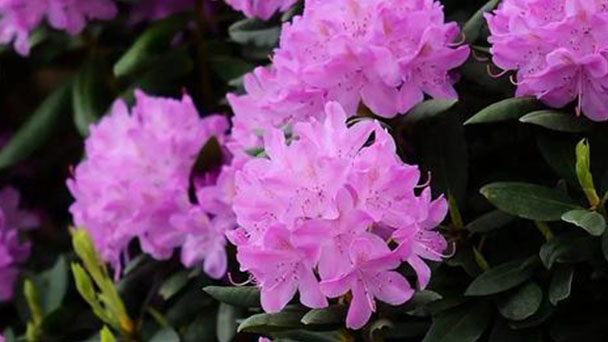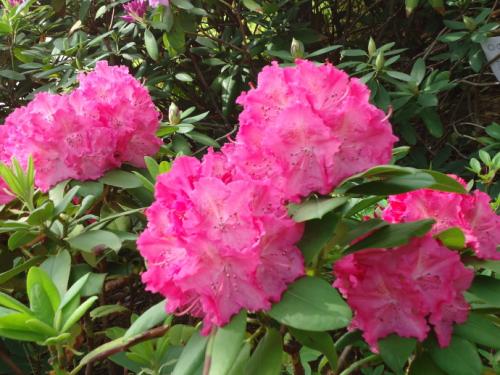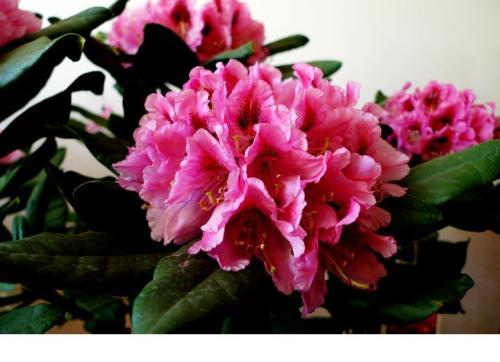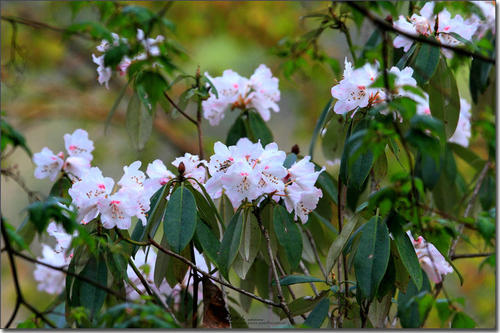Lapland Rosebay (Rhododendron lapponicum) profile
Written by Maggie
Aug 31 2021

Lapland Rosebay (Rhododendron lapponicum (L.) Wahl.) is a small evergreen shrub, up to 1 m tall, densely branched, prostrate or erect. Leaves are often scattered at the top of branches, leathery, above light gray to dark grayish green, below light yellowish-brown to reddish-brown, petiole is scaly.
Lapland Rosebay picture

Morphological characteristics of lapland rosebay
Lapland Rosebay is a small green shrub, 20-45 (-100) cm tall, densely branched, short or slender, propulsive or erect. Young branchlets are densely rusted brown scales mixed with pilose, glabrescent. Leaf bud scales caducous. Leaves of Lapland Rosebay are often scattered, was born in the top branches, leathery, oblong-elliptic elliptic to oblong, oval or oblong-elliptic obovate, 4 - (25) 15 mm long, 2-5 (9) mm wide, apex obtuse, with a short process point, base broadly cuneate, margin slightly revolute, above the light grey to dark grey green, matt, densely covered with several contiguous or overlapping, gray scales below yellow brown to reddish brown, densely covered with pale brown spots and brown rust color hue of the mixed two scales, a few are equal, adjacent or overlapping;Petiole 1.5 -- 4 mm long, scaly.
Inflorescences of lapland rosebay are terminal, umbellate, with (2) 3-5 (6) flowers; Flower bud scales abscission; Pedicels are 3-6 mm long, fruiting elongate to 12 mm;Calyx small, (0.5-) 1 -- 2 mm long, reddish or purple, lobes 5, ovate-triangular or suborbicular, sparsely or densely scaled, margin long ciliate or occasionally scaly; Corolla of Lapland Rosebay is broadly funnelform, (6.5-) 7-13 (-16) mm long, lavender rose to purple, rarely white, outer without scales, glabrous, floral tubes (1.5-) 2-5 (-6) mm long, inner throat pilose, lobes 5, spreading, longer than floral tubes; Lapland Rosebay has 5-10 stamens, ca. As long as corolla, filaments woolly at base; Ovary is 5-loculed, 1.2 mm long, densely scaly, style 1.1-1.5 cm long, longer than stamens, smooth. Capsule of Lapland Rosebay is oblong-ovate, 3-6 mm long, densely scaly.
Ecological habits of lapland rosebay
Soil
Lapland Rosebay requires loose and acidic soil with a pH of 4-6. Wild and Lapland Rosebay are suitable for growing acidic soil with a pH of about 4.5, and most rhododendrons like pH of 4.5-6.0. Studies have reported that cutting survival rate is the highest when pH4-5, but the length and quality of stem growth and root growth are the best when pH4. The pH value is greater than 7 and the heavy clay will not grow well
Light
The light compensation point and light saturation point are the quantitative indicators of the light requirement of plants. When the relative light intensity reaches about 60%, the growth, development and flowering of rhododendron reach the best. Lapland Rosebay likes light, but also afraid of strong light, is a half shade plant.
Lapland rosebay distribution
Lapland Rosebay grows on high mountains, tundra, rocky places, or swampy areas.China's Sichuan Emei Mountain, Yunnan Yongshan region, the northeast of the Great Hinggan Mountains, Changbai Mountains and Inner Mongolia. Discontinuous distribution around the Arctic Greenland, Scandinavia, northern Korea, eastern Siberia and Sakhalin Island (Sakhalin Island), Canada, Alaska.
Lapland rosebay propagation methods
Cutting propagation
Cutting propagation is most used in the course of cultivation of Lapland Rosebay propagation methods, generally spring shearing robust half lignification sections, 5-8 cm long, cut off the lower leaves, keep the parietal lobe 2-3 pieces as cuttings, cuttings base had better use indolebutyric acid or ABT ABT dip dip in processing such as solution, then cutting in osteoporosis breathable, acidic soil rich in humus, keep temperature in 20 to 25 ℃, shade and often spray moisturizing, so as to promote new root germination.
Twig propagation
For rare varieties that are difficult to survive, such as Lapland Rosebay, first cut off the tender branches about 3-4 cm as scion, cut the base into wedges with a sharp knife, use rhododendron as rootstock, use the tender branches split, and then put under the shade with plastic film binding, and use plastic bags to cover the scion and rootstock together to protect moisture.

How to grow and care for lapland rosebay
Lapland Rosebay is mostly used for potted ornamental plants, which prefer cold, high humidity environments and require large amounts of water due to its large canopy. It is a shallow-rooted tree with a developed root system. The cultivation substrate should be loose and rich in humus. The soil aggregates should have good structure and the pH value should be between 5.5 and 6.5. Lapland Rosebay could not withstand high temperatures and grow poorly over 35℃, but could withstand severe cold at -10℃, so it could survive the winter safely in Jiangnan areas such as Shanghai, Wuxi and Suzhou.
Water care
The growth and development of Lapland Rosebay require acid soil. Because the northern soil is more alkaline, so the basin soil needs to be mixed with decaying pine coniferous soil and other humus soil. The root system of rhododendron is the fine root with whisker shape, and the requirements of fertilizer concentration and water quality are strict. The principle of timely and proper amount and frequent application of thin fertilizer should be followed when applying fertilizer. In order to promote the Lapland Rosebay growth of branches, leaves and buds before spring flowering, phosphate fertilizer can be applied once a month. After anthesis, apply a mixture of nitrogen and phosphorus for 1-2 times. Phosphorus fertilizer was applied 1-2 times during the gestation period in spring.
In the growing period, flowering period fertilizer and water requirements are more, winter dormancy, summer growth is slow to control the fertilizer and water, in order to prevent root rot. Lapland Rosebay likes wet and cool environments, the northern climate is dry, should be timely watering and spray, to maintain high air humidity.Water with alum fertilizer water and rain water as well, such as common water to add a small amount of ferrous sulfate and vinegar. Also can cut watermelon or tomato into small pieces apply, also have a good effect to improve soil quality and flower quality.
The plastic clip
In order to accelerate the Lapland Rosebay blooming, Lapland Rosebay often through the heart to promote new branches, for flowers cluster, affect the shape of the flower can be early sparring bud, so not only make the year flowers big color fresh, but also conducive to the plant next year growth and flowering. The germination ability of rhododendron is strong, the branches seriously affect the growth and development of the Lapland Rosebay, and reduce its ornamental and commercial properties, so it needs to be adjusted by pruning. Pruning is generally carried out in the spring after the flower has faded and autumn. Cut off dead branches, inclined branches, long branches, diseases and insects and some cross branches to avoid nutrient consumption and make the whole plant blossom and plump.
Flowering control
The flower bud differentiation of Lapland Rosebay in autumn can be controlled artificially by cold storage and heating treatment. To make the Lapland Rosebay blossom in advance, it can be moved to the greenhouse culture, control the temperature at 20-25℃, and often in the branches and leaves of water, maintain more than 80% of the relative humidity, so that after a month and a half can blossom. To make the rhododendron delayed flowering, can form the rhododendron bud, let it has been in a low temperature state, maintain the temperature of 2-4℃, pot dry water, summer and autumn moved out of the outdoor, after 2 weeks can be flowering.
Disease control in lapland rosebay
Swelling of the disease
1:1:200 Bordeaux liquid can be sprayed before the onset of disease, especially when the leaf is extracted, and the disinfected leaves can be removed in time. Before germination can be sprayed with 0.3-0.5 Baume sulphur mixture or 1:1:200 Bordeaux liquid 2-3 times, usually every 7-10 days spray 1 times; After the disease can be sprayed 65-80% mancozeb 500 times liquid or 0.3-0.5 pompeii degree sulphur mixture 3-4 times, every 7-10 days spray 1 times.
Leaf spot
Leaf spot and brown spot. From spring to summer, 1000 times 70% methyl torbuzine solution, 4000 times 20% powder ruining solution and 500 times 50% mancozeb solution were sprayed once every 10 days, a total of 7 to 8 times, which could effectively control the development of the disease. In order to prevent leaf yellowing, ferrous sulfate can also be added.
Currency urban disease
Victimized tender branch leaf tip is full of dense white or pink mite quality layer, sometimes the leaf mite gall, caused by aphid stab leaf infection. Its prevention and control methods: in the removal of diseased leaves at the same time, spray containing copper sulfate; Aphids and other stinging pests can be controlled by spraying oxidized dimethyl oil or by placing carbofuran directly in the basin.
The use of lapland rosebay
Lapland Rosebay with lush foliage, beautiful scene, strong germination, pruning resistance, peculiar root pile, is an excellent bonsai material. In the garden, Lapland Rosebay is best to plant in clusters along the edge of forests, streams, pools and rocks. Lapland Rosebay can also be planted in scattered areas under open forests. Lapland Rosebay is a good material for flower hedges. The dark green leaves are well planted as a low wall or screen in the garden, even though the rhododendron is always noisy and noisy when in bloom, rather than in bloom.

Latest Updated
- Benefits of Bugleweed - 7 Science-backed Health Benefits
- Bugleweed Dangers & Side Effects - Is It Poisonous?
- How to Plant Evergreen Trees - What You Should Know
- When to Plant Evergreens - Grow Guide for Evergreen Trees
- 12 Wonderful Evergreen Shrubs for Your Garden
- 12 Popular Evergreen Plants with Pictures for Beginners
- When And How To Prune A Lilac Bush Like a Pro
- How to Grow & Care for Lilac Vine (Hardenbergia Violacea)
- Japanese Lilac Tree (Syringa Reticulata) Care & Propagation Guide
- Shumard Oak Pros and Cons - What to Know
Popular Articles
- Winter maintenance of Antirrhinum Majus
- How to Grow Terminalia Mantaly Tree
- How to Grow and Care for Crossostephium Chinense
- How to grow Antirrhinum Majus in spring
- Peristeria Elata (Dove Orchid) Profile: Info & Care Guide
- Underwatered Snake Plant (Sansevieria Trifasciata) - Signs And How To Fix
- How to Care for Brazilian Jasmine Plant (Mandevilla Sanderi)
- How to Grow & Care for Graptopetalum Purple Delight in Summer
- Rosa Chinensis (China Rose): Plant Growing & Care Tips
- How to Care for Baby Sun Rose (Aptenia Cordifolia)